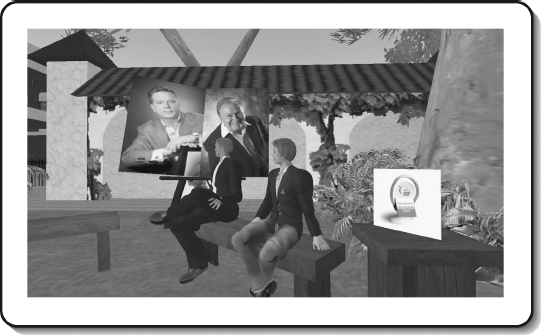What You Need to Know
A virtual world, or virtual environment, is usually an Internet-based simulated environment inhabited by avatars, or graphic representations, of its interactive users. An avatar can be represented textually, by a photograph, logo, image, or a 3-D cartoonlike person, animal, or object. While not all virtual worlds are 3-D, many began as forums, blogs, and chat rooms in which communities and trusted networks were created.
Figure 15.9 shows examples of two avatars used in Second Life—those of Mark Kingdon, CEO of Linden Labs, creator of Second Life, and Lon Safko. Mark’s photo is on the left; his avatar is to Lon’s right.
FIGURE 15.9 Kingdon and Safko Avatars. Mark Kingdon, CEO of Linden Labs (Second Life), and Lon Safko (author) avatars discussing social media.

Virtual worlds are often mistaken for user-immersed games in which players navigate their way through a simulated environment, shooting, fighting, and interacting with other players’ avatars (that are controlled either by humans or the game itself) with the goal of winning or overcoming a predetermined challenge. While virtual worlds may appear similar to and were inspired by these types of games, they are designed to serve a completely dissimilar ...
Get The Social Media Bible: Tactics, Tools, and Strategies for Business Success, 3rd Edition now with the O’Reilly learning platform.
O’Reilly members experience books, live events, courses curated by job role, and more from O’Reilly and nearly 200 top publishers.


